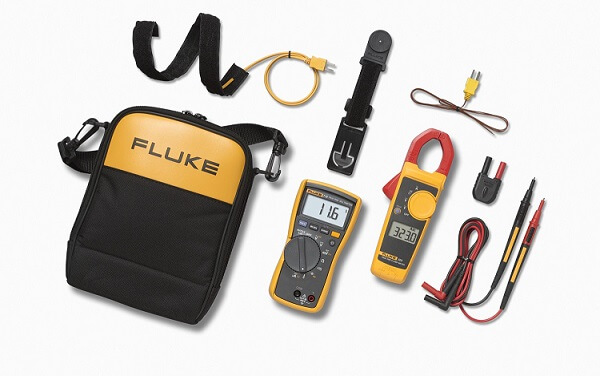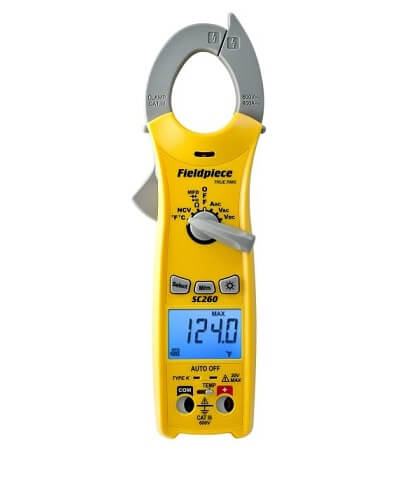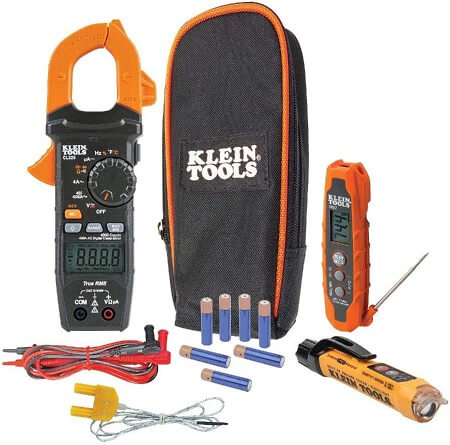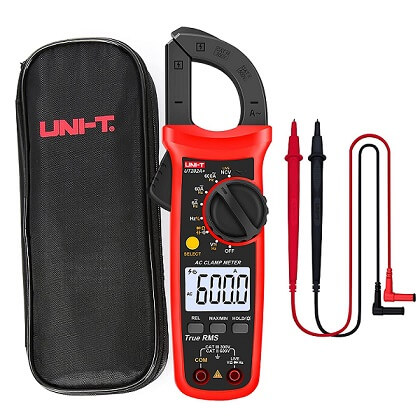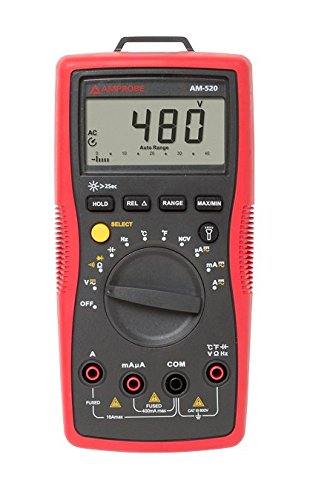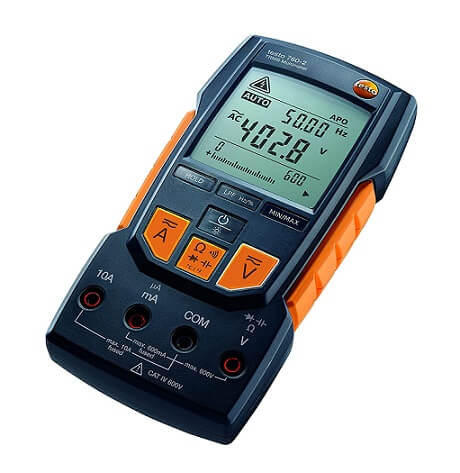An HVAC multimeter is an indispensable tool for professionals working in the heating, ventilation, and air conditioning (HVAC) industry. This specialized multimeter is designed to measure electrical parameters, temperature, and other critical functions necessary for installing, troubleshooting, and maintaining HVAC systems effectively.
Key Factors:
- Manual vs Auto Ranging We considered both manual and auto-ranging multimeters. Manual ranging multimeters require the user to select the range of measurement, offering precision and control for experienced users. Auto-ranging multimeters, on the other hand, automatically adjust to the correct measurement range, making them convenient and user-friendly, especially for those new to using these devices.
- True RMS True RMS (Root Mean Square) measurement capability was another critical factor. True RMS multimeters provide accurate readings for both pure sine waves and varied or distorted AC waveforms, which are common in HVAC applications. This feature ensures that technicians get precise measurements regardless of waveform irregularities.
- Measurement Ranges of voltage, current, resistance, capacitance, and temperature were closely examined. Multimeters that offer wider and more versatile measurement ranges were prioritized, as they can accommodate a broader spectrum of HVAC systems and scenarios. This versatility is crucial for professionals who deal with a wide array of HVAC equipment and problems.
We will be explaining each of our picks on this list along with some handy information provided in our “Buying Guide” to give you a complete idea about what you should know before buying an HVAC multimeter.
Outline
ToggleBest HVAC Multimeter
| Best HVAC Multimeter | Power Type | Voltage AC/DC | Resistance | Buy Now |
|---|---|---|---|---|
| Fluke 116/323 Multimeter | Battery Powered | Up to 600 Volts | Up to 40 MΩ | Check On Amazon |
| Fieldpiece HVACR Clamp Multimeter | Battery Powered | Up to 600 Volts | Up to 40 MΩ | Check On Amazon |
| Fluke HVAC Multimeters | Battery Powered | Up to 600 Volts | Up to 40MΩ | Check On Amazon |
| Klein Tools HVAC Kit | Battery Powered | Up to 1000 Volts | - | Check On Amazon |
| UNI-T Digital Clamp Meter | Corded Electric, Battery Powered | 600 Volts | Up to 60MΩ | Check On Amazon |
| Amprobe HVAC Multimeter | Corded Electric | 600 Volts | Up to 40 MΩ | Check On Amazon |
| Testo Digital Multimeter | Corded Electric | 600 Volts | - | Check On Amazon |
Also Check –
Best HVAC Multimeter Reviews
1. Fluke 116/323 Multimeter
Fluke is one of the leading suppliers across the country for electronic measurement devices and accessories, especially curated for the professionals. If you also need such a multimeter, check out this option from Fluke.
The Fluke 116/323 Multimeter and Clamp Meter is our top choice for the best HVAC multimeter for its wide range of features and accessibility features. Unlike many other options, the Fluke 116/323 Multimeter and Clamp Meter is an all-in-one HVAC combo kit with support for almost all types of measurements that you would need. It also comes with a built-in thermometer to offer a wide range of temperature range for measurement.
Apart from that, the Fluke 116/323 Multimeter and Clamp Meter offers micro amps that allows you to test flame sensors, a feature that is exclusive to this device. The low input impedance on the other hand prevens false or misleading readings, giving you precise and accurate results which is needed for professional applications. This device is capable of measuring up to 400A AC current and 600 VAC as well as DC voltage.
Best Features
- Battery-powered HVAC multimeter
- Offers up to 600 Volts voltage range
- Up to 40 MΩ resistance can be measured
- All necessary accessories are included
Pros
- Perfect option for professional applications
- Offers many additional features and testing modes
- Comes with a large display
Cons
- Not the best option for basic applications
2. Fieldpiece HVACR Clamp Multimeter
Fieldpiece is also one of the most trusted brands for electronic devices such as multimeters, vacuum gauges, HVAC charge and air kits, and much more. Therefore, we have included this great option from Fieldpiece on this list.
In 2nd place, we have the Fieldpiece Compact HVACR Clamp Multimeter SC260. As the name suggests, this is more of a compact and highly portable multimeter which is rather budget friendly for its applicability. This is a true RMS clamp meter with temperature as well as capacitance measurement features. The Fieldpiece Compact HVACR Clamp Multimeter SC260 is specifically designed for HVAC systems and works perfectly in cold as well as hot environments.
As for the durability, Fieldpiece has managed to offer a rugged build quality even with the compact form factor with the Fieldpiece Compact HVACR Clamp Multimeter SC260. You can also go with the non contact type of measurement for voltage and amperage readings for added safety. Plus, it can be used for continuity warning & diode tests that are crucial for checking the blower motor for an HVAC system. The Fieldpiece Compact HVACR Clamp Multimeter SC260 can automatically detect if its being used for capacitance or resistance measurements, making your job even easier.
Best Features
- Battery-powered HVAC multimeter
- Offers up to 600 Volts voltage range
- Up to 40 MΩ resistance can be measured
- One of the highly compact and portable options
Pros
- Offers non contact measurement for voltage and amperage tests
- Supports continuity warning & diode test
- Auto select mode for easy of usage
Cons
- The display is very compact
3. Fluke HVAC Multimeters
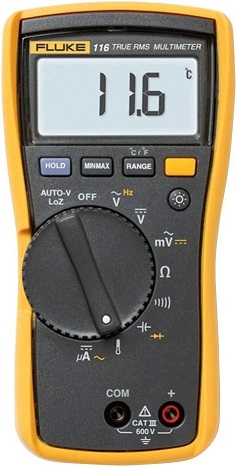
The built-in thermometer was impressive, providing accurate temperature readings compared to other thermometers. Whether was working on household projects or HVAC tasks, it performed reliably. You must view it at a specific angle to see clearly. Now, the LCD display could use improvement. I hope Fluke considers upgrading this in future versions.
One thing I noticed was the change in meter leads. They used to be rubber-coated, but now they are plastic-coated, which makes them less flexible and harder to bend and store properly.
Overall, the Fluke 116 HVAC Multimeter is a top-notch tool. Despite some minor drawbacks, it delivers on its promises. If you need a reliable HVAC multimeter, try Fluke 116.
Best Features
- Built-in thermometer
- Microamps to test flame sensors
- Large white LED backlight
- Resistance, continuity, frequency, and capacitance
- CAT III 600 V safety rated
Pros
- Comprehensive features for HVAC applications
- Reliable performance
- Built-in thermometer for measuring temperatures
- Microamps to test flame sensors
- Large white LED backlight for work in poorly lit areas
- CAT III 600 V safety rated
Cons
- Can be expensive
- Not as portable as some other multimeters
- Not as accurate as some other multimeters
4. Klein Tools HVAC Kit
Moving on to the budget range of options suitable for basic needs, we have a great option coming from Klein Tools. You might have probably heard about this brand before since it also produces a variety of hand tools and testing apparatus.
The Klein Tools CL320KIT HVAC Kit is also an all-in-one option that we have for the best HVAC multimeters. This multimeter features dual IR/probe design with a built-in thermometer and a dual range non contact voltage tester for safer application. The Klein Tools CL320KIT HVAC Kit is also backed by TRMS technology so that it can measure AC current, NCVT, AC as well as DC voltage, resistance, frequency, duty cycle, continuity, and many other factors without any problem.
The thermocouple used with the Klein Tools CL320KIT HVAC Kit is especially interesting since it offers a supported temperature range of -40 to 572 degrees Fahrenheit , making it a suitable choice for domestic as well as commercial HVAC systems. You can also check the surface temperature via the infrared thermometer for contact less type of testing that ensures your as well as the device’s safety. And where that is not possible, you can use the probe which comes in handy for measuring temperatures around air vents and ducts.
Best Features
- Battery-powered HVAC multimeter
- Offers up to 1000 Volts voltage range
- -40 to 572 degrees Fahrenheit temperature range
- Dual IR/Probe Thermometer
Pros
- Many great features are implemented
- Comparatively cheaper alternative for an HVAC multimeter
- Very safe options with all factors considered
Cons
- Some features are excessive regarding basic applications
5. UNI-T Digital Clamp Meter
So far, we have seen the best options for an HVAC multimeter that you would find useful for professional applications. But for personal usage, there are some highly affordable options made by brands like UNI-T that are a perfect pick.
The UNI-T Digital Clamp Meter UT202A+ is the most affordable choice we have for our list of the best HVAC multimeters today. But, it still offers the auto ranging features which is surely an important feature for getting quicker results, especially for those who do not have previous experience with a multimeter. It is a perfect option for domestic applications as it supports live wire detection, NCV detection, relative testing mode, etc. So, you can use the UNI-T Digital Clamp Meter UT202A+ for HVAC systems as well as automotive and even standard electrical problems.
The UNI-T Digital Clamp Meter UT202A+ is rated for 6000 counts so that there is almost no margin for errors on this device. It can measure up to 600A max AC current, AC current frequency, up to 600 Volts AC/DC voltage, voltage frequency, resistance, capacitance, and much more. The UNI-T Digital Clamp Meter UT202A+ also has a high safety rating which is admirable for such a cheaper device. On top of that, you also get 18 months of warranty on the UNI-T Digital Clamp Meter UT202A+ for a worry-free purchase.
Best Features
- Corded Electric/Battery-powered HVAC multimeter
- Offers up to 600 Volts voltage range
- Up to 60 MΩ resistance can be measured
- Comes with 18 months of warranty
Pros
- Highly reliable choice despite the affordability
- 6000 counts rated display
- Capable of measuring many different aspects
Cons
- Measurement ranges should have been wider
6. Amprobe HVAC Multimeter
Coming up next, we have one more HVAC multimeter suitable for basic applications designed by Amprobe. You will notice that Amprobe has paid close attention to some important features of the device and made it very easy to use.
The Amprobe – 4018649 AM-520 HVAC Multimeter is also one of the budget options that are included on this list of the best HVAC multimeter. This device also supports non-contact voltage and temperature detection which is what most users need. It makes the job very easy and safe and you can use the device without any professional help. As for the testing range, the Amprobe – 4018649 AM-520 HVAC Multimeter is capable of measuring up to 600 Volts AC or DC voltage, AC or DC current, resistance, and frequency.
If you are planning to use the Amprobe – 4018649 AM-520 HVAC Multimeter for startup capacitors, you can do that since it supports capacitance testing as well. On top of that, you will also find support for microamps that enables testing of flame sensors. As for reliability testing such as diode test or duty cycle test for troubleshooting, it is also covered by the Amprobe – 4018649 AM-520 HVAC Multimeter. The display of this multimeter is also quite large and easily visible under bright light.
Best Features
- Corded Electric HVAC multimeter
- Offers up to 600 Volts voltage range
- Up to 40 MΩ resistance can be measured
- Many types of testings are supported
Pros
- Highly versatile HVAC multimeter
- Backlit LCD display
- Non-contact voltage and temperature detection
Cons
- Build quality could have been better
7. Testo Digital Multimeter
Lastly, we are bringing yet another durable and premium option for an HVAC multimeter designed for professional applications. This multimeter is made by Testo and is one of the finest options from its wide range of HVAC, combustion, emission, and flue gas testing equipment.
In the end, we have the Testo 760-2 Digital Multimeter on our list of the best HVAC multimeters. This is also a premium option best-suited for professional applications. It offers true RMS measurements so that you can use the Testo 760-2 Digital Multimeter for a variety of testing on HVAC systems and get quick and accurate results. It is also equipped with an auto-test setup that minimizes the prep time and lets you carry out the tests quickly.
ANd to further minimize possibilities for error and increase the accuracy of results, the Testo 760-2 Digital Multimeter automatically detects the testing circuit and selects the right range and meter configuration for the job. One of the best features of the Testo 760-2 Digital Multimeter is its build quality. From the outside, you will notice a rugged exterior that makes the device a perfect choice for outdoor usage. Also, the LCD display on the Testo 760-2 Digital Multimeter is comparatively larger than most other options around this price point.
Best Features
- Corded Electric HVAC multimeter
- Offers up to 600 Volts voltage range
- Comes with a large display
- Supports auto ranging
Pros
- One of the best options for outdoor usage
- Build quality is very good
- Large and easily accessible display
Cons
- Requires 3 AAA batteries to work
Buying Guide For The Best HVAC Multimeter
When selecting the best HVAC multimeter for your needs, there are several critical factors to consider. These instruments are pivotal in diagnosing and maintaining heating, ventilation, and air conditioning systems, making the choice of the right multimeter crucial. Below, we delve into the essential aspects of HVAC multimeters:
1. Manual vs Auto Ranging
Why It Matters: The choice between manual and auto-ranging affects how you interact with your multimeter. Manual ranging multimeters require the user to know and select the appropriate measurement range before testing. This can lead to greater precision but requires a deeper understanding of the device you’re testing. Auto-ranging multimeters, conversely, simplify the measurement process by automatically detecting and setting the correct range, saving time and reducing the chance of error, especially for less experienced users.
What to Look For: Consider your level of experience and the types of tasks you frequently perform. If you value speed and convenience for a wide range of tasks, an auto-ranging multimeter might be preferable. For those who perform highly specialized measurements and prefer control over the process, a manual ranging multimeter could be the better option.
2. True RMS
Why It Matters: True RMS (Root Mean Square) capability is essential for accurately measuring AC voltage or current in non-linear loads. Non-linear loads, common in HVAC systems due to variable speed drives and electronic ballasts, can produce distorted waveforms. A True RMS multimeter accurately measures these distorted waveforms, ensuring the readings are precise.
What to Look For: Ensure the multimeter specifies True RMS functionality. This feature is crucial for HVAC professionals who need accurate readings in a variety of electrical environments. It’s particularly important when working with systems that include motors, compressors, or other components that can cause waveform distortion.
3. Measurement Ranges
The versatility of a multimeter in HVAC applications significantly depends on its available measurement ranges. Let’s break down why each range matters and what to look for.
a. Voltage
Why It Matters: Accurate voltage measurement is fundamental for diagnosing electrical issues in HVAC systems. HVAC systems can vary widely in their voltage requirements, from low-voltage control circuits to high-voltage power supplies.
What to Look For: Look for a multimeter that can measure both AC and DC voltage. A range of 0-600V for AC and 0-600V for DC should cover most HVAC applications.
b. Current
Why It Matters: Measuring current is essential for assessing the electrical load and performance of an HVAC system. It can help identify overloads or inefficiencies.
What to Look For: A multimeter with the ability to measure both AC and DC current, with a range up to at least 10A for AC and DC, is desirable. Some multimeters offer clamp attachments or integrated clamp meters to measure current without breaking the circuit.
c. Continuity and Diode
Why It Matters: Continuity testing is crucial for ensuring there are no breaks in electrical connections or wires. Diode testing is important for checking the polarity and integrity of diodes in circuits.
What to Look For: A multimeter that provides an audible continuity test makes it easier to focus on the test probes and the circuit being tested. For diode testing, look for a multimeter that can measure diode forward voltage drop, indicating the diode’s health.
4. Accuracy
Why It Matters: Accuracy is the cornerstone of any measurement tool. In HVAC work, where precise readings can dictate the next steps in troubleshooting or system design, having a multimeter that provides accurate measurements of voltage, current, resistance, etc., is non-negotiable. The accuracy of a multimeter is usually expressed as a percentage of reading plus a number of least significant digits (e.g., ±(1.0% + 2)).
What to Look For: Seek out multimeters that clearly specify their accuracy for various measurements. Remember, accuracy may vary between functions (e.g., voltage vs. resistance measurements). Ideally, look for a device with an accuracy of ±(0.5% + 2) for voltage measurements and similar precision for other functions relevant to HVAC work.
5. Temperature Sensor
Why It Matters: HVAC systems are all about temperature control, making the ability to measure temperature directly with your multimeter an invaluable feature. Whether you’re assessing the refrigerant temperature, air supply, or system components, a built-in temperature sensor can simplify your workflow and provide immediate diagnostics insights.
What to Look For: Opt for a multimeter that includes a thermocouple or other temperature sensor capable of measuring a wide temperature range, ideally from -40°C to 400°C (-40°F to 752°F). This range should cover most HVAC applications, from checking freezer operations to monitoring furnace output.
6. Non-Contact Voltage Testing
Why It Matters: Safety is paramount in any electrical work, and HVAC systems are no exception. Non-contact voltage testing allows you to detect electrical current in wires, breakers, or outlets without making physical contact, significantly reducing the risk of electric shock. This feature is particularly useful for quickly checking for live circuits before beginning work.
What to Look For: Look for a multimeter with a reliable and sensitive non-contact voltage (NCV) tester. The sensitivity should be adjustable or adequately tuned to detect standard AC voltage ranges found in residential and commercial buildings (typically 90V to 1000V AC). Some multimeters also provide visual and auditory indicators when voltage is detected, enhancing safety and convenience.
7. Safety Features & CAT Rating
Why It Matters: Safety is paramount when working with electrical systems. A multimeter’s safety features and CAT (Category) rating indicate how well the device can handle sudden surges in electrical power, which are common in many HVAC applications. The CAT rating specifically reflects the maximum voltage the multimeter can safely withstand and is a critical factor in preventing accidents and equipment damage.
What to Look For: Multimeters are categorized into CAT I, CAT II, CAT III, and CAT IV, with CAT IV being suitable for outdoor and industrial applications where higher power levels and potential surge voltages exist. For HVAC work, a CAT III rating up to 600V or even 1000V is generally sufficient, covering most residential and commercial electrical systems. Additionally, look for features like fuse protection, insulated probes, and rugged construction to enhance overall safety.
8. Display Parameters
Why It Matters: The display on a multimeter not only shows measurement readings but also significantly affects how easily and quickly you can interpret data, especially in low-light conditions or when multitasking. A clear, readable display with backlighting and a high contrast ratio can reduce eye strain and make it easier to work for extended periods.
What to Look For: Opt for multimeters with large, backlit displays that support at least a 4-digit readout (6000 counts or higher) for precision. Features like a bar graph, min/max/average recording, and a hold function can also be invaluable for tracking fluctuations over time or capturing a measurement at a precise moment. Digital displays with real-time updates and easy-to-navigate interfaces enhance usability and efficiency on the job.
9. Included Probes and Accessories
Why It Matters: The probes and accessories that come with your HVAC multimeter can significantly expand its range of applications and the accuracy of your measurements. Quality probes ensure secure, stable connections and accurate readings, while additional accessories like thermocouples for temperature measurements or clamp attachments for current readings can greatly enhance the multimeter’s versatility.
What to Look For: Ensure your multimeter comes with a set of durable, insulated probes suitable for the type of work you do most often. Look for kits that include a variety of probe tips (e.g., alligator clips, needle tips) for different testing scenarios. Additional accessories like protective carrying cases, temperature probes, and non-contact voltage testers add value and functionality to your investment. Compatibility with modular attachments or the ability to easily replace worn-out probes is also a plus, ensuring your multimeter can adapt to various tasks and last longer.
Frequently Asked Questions
Ans: Before you can start using an HVAC multimeter, we will suggest checking out the instructions manual that is included with the device to get a complete idea about the multimeter. Even though the basic working principle is pretty much the same for all devices, it differs a little bit from device to device based on the manufacturer. You can also find tutorial videos on the manufacturer’s website about the device to get a complete idea of how to use it. Once you have set up the multimeter, all you will have to do is select the right measurement mode with the help of the rotor selector wheel and connect the probes to get an output.
Ans: The default memory is different for different multimeters. So, the number of observations that you can save on your HVAC multimeter can be different from its competitors. If you are going with a budget option, it might not even have an onboard memory chip in the first place. Thus, preventing you from saving any observations at all. However, almost all standard HVAC multimeters feature onboard memory with enough storage capacity to store up to 400 readings on the device, if not more.
Ans: Yes, it is possible to check the aspects of an HVAC blower motor if you are purchasing an HVAC multimeter. With such a device, you can check various aspects of the motor such as supply voltage, current, winding continuity, resistance, and much more. To do that, simply connect the red and black test probes to the 2 or 3-phase wiring of the motor and check the display for results. For testing the current, you will have to use the clamp head of the meter and select the current range option via the rotary switch. As for the continuity of the winding, simply cut off the power supply of the motor, and then you can check the continuity of winding via the connection box of the motor.
Conclusion
In this article, we’re highlighting the top HVAC multimeters available, ensuring you find a reliable and accurate tool without the hassle of extensive research. These multimeters are well-reviewed by users, capable of measuring essential HVAC system parameters like current, voltage, and resistance. Advanced models also assess temperature, capacitance, frequency, and duty cycles.
- For basic needs and affordability, consider the UNI-T Digital Clamp Meter, offering auto-ranging, true RMS, and up to 600 volts measurement at an entry-level price.
- For professionals requiring comprehensive functionality, the Fluke 116/323 Multimeter stands out with its built-in thermometer and microamps feature for flame sensor testing.
- Another excellent option is the Fluke HVAC Multimeters, balancing high-end features with cost-effectiveness, including a 600 volts measurement capability and an integrated temperature sensor for convenient measurements.
These recommendations cater to both basic and advanced needs, ensuring quality and efficiency in your HVAC maintenance tasks.

